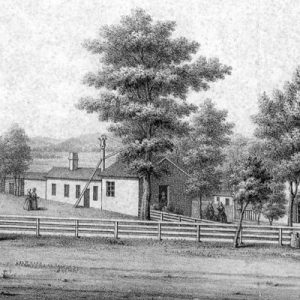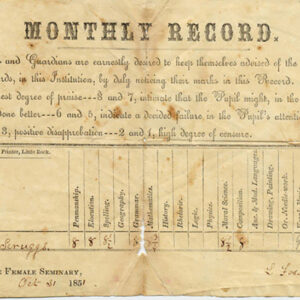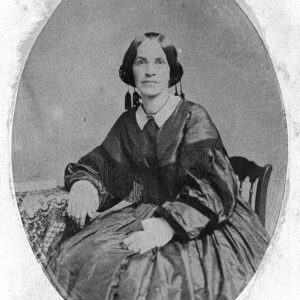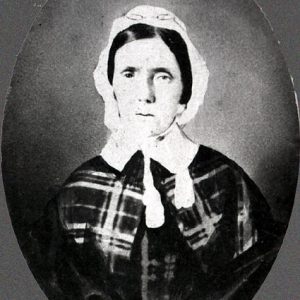calsfoundation@cals.org
Fayetteville Female Seminary
One of the most influential institutions in early Arkansas was the Fayetteville Female Seminary in Fayetteville (Washington County), which provided a quality education for girls throughout the region in a time when most women received little, if any, schooling. It also accepted both Cherokee and white students in an era when the “mixing of the races” was discouraged. Though it was only in existence from 1839 through 1862, the Fayetteville Female Seminary is often cited as one of the factors leading to the location of the state’s land-grant university, the University of Arkansas (UA) in Fayetteville.
The Fayetteville Female Seminary was created by Sophia Sawyer of Rindge, New Hampshire. She went to Georgia 1823 as a missionary to the Cherokee through the American Board of Missions, joining one of the leading clans, the Ridge family, as a private tutor. She was once confronted by the Georgia militia for the crime of teaching African-American children (who were slaves of the Cherokees) to read. She turned the men away, saying that she was not subject to Georgia law since she was in Indian Territory and the Cherokee were too civilized to have such a law.
She stayed with the Ridge family during the forced removal of the Cherokee from Georgia on the infamous Trail of Tears (1838–39) through Tennessee, Arkansas, and Indian Territory in modern-day Oklahoma. After the murder of tribal leader John Ridge at Honey Creek, Oklahoma, by members of a rival faction on June 22, 1839, Sawyer and the dead man’s widow, Sarah Bird Northrup Ridge, fled with fourteen Cherokee girls, including the Ridge children, to the relative safety of Fayetteville. The girls were from noble Cherokee families, seeking both an education and relief from the violence of the Indian Territory.
Sawyer and Ridge set up a school in 1839 with about twenty students, including the fourteen Cherokee girls, upstairs at the Fayetteville courthouse, then on the second floor of a theater on the town square. Fearing the bad influence on the girls from the actors at the theater, Sawyer asked a prominent local attorney, Judge David Walker, to donate land for a school building in a more sheltered location. Judge Walker provided land on Fayetteville’s Block 33, at the corner of today’s Mountain and School streets, and the school opened at that location in 1841.
Tuition for the basic five-month term was eight dollars. The Fayetteville Female Seminary soon became known as an outstanding school, generally attracting about fifty young ladies of distinguished families from all over the region. They took classes including music, literature, French, and embroidery and either boarded in a dormitory at the school or with neighboring families.
Some of the instructors at the Fayetteville Female Seminary were significant educators in early Arkansas, including Lucretia Foster Smith, the Reverend Cephas Washburn, Madame Marie Janssen, who taught French and embroidery, Mary T. Daniels, who acted as associate principal, and Ferdinand Zellner, a music professor who composed “The Fayetteville Polka” and went on to conduct the San Francisco Symphony. In 1852, Alderman J. M. Van Hoose said of the school, “Many beautiful young ladies from Missouri, the Indian country and South Arkansas attend this school. These school girls and the young men from Arkansas College together with the young men of the town and our own beautiful young ladies make Fayetteville society second to none in the state.”
The school was not affiliated with any particular religious group, and since both white and Cherokee students attended the school, Sawyer occasionally received letters from local citizens who objected. Sophia Sawyer died of tuberculosis on February 22, 1854, at the age of sixty-one. Hers was the first recorded burial in Fayetteville’s Evergreen Cemetery, which had just been established as Fayetteville’s “City of the Dead.”
Lucretia Foster Smith became principal following Sawyer’s death. Until that time, Sophia Sawyer was the school’s first and only principal. The school was incorporated in 1859 and had 103 students at its peak that same year. Many of the daughters of leading northwest Arkansas families attended the school, including the Ridge children and young ladies such as Matilda Winlock, who arrived from Kentucky and married prominent local attorney Jonas Tebbetts; he had first noticed her as a fifteen-year-old schoolgirl.
The school flourished until the coming of the Civil War. Much of the city was torched by retreating Confederates on February 20, 1862. According to William S. Campbell, the fires reached the school, where women and children formed a bucket brigade to try to save the school, but managed to preserve only a sixteen-square-foot portion of the original log building. Wounded Union soldiers were reportedly brought to the school site following the Battle of Prairie Grove in 1862. The log building was removed in 1923 to the Miller farm four miles north of town and turned into a stable, which no longer exists.
But the Fayetteville Female Seminary’s mission ultimately lived on. When the time came to award the location of state’s land-grant university in 1871, it was generally assumed at first that the honor would go to an established, easily accessible town in central Arkansas. However, Arkansas Industrial University (now the University of Arkansas) was awarded to Fayetteville due to its reputation as an early seat of educational excellence. Today, there is a historical marker in Fayetteville on Mountain Street, between Locust and School streets west of the Square, honoring the Fayetteville Female Seminary.
For additional information:
Campbell, William S. One Hundred Years of Fayetteville 1828–1928. Fayetteville, AR: Washington County Historical Society, 1977.
Castelow, Teri L. “Miss Sophia Sawyer: Founder of the Fayetteville Female Seminary.” Arkansas Historical Quarterly 68 (Summer 2009): 176–200.
“Miss Sophia Sawyer and Her School.” Flashback 23 (August 1973): 3–22 and (November 1973): 9–26; Flashback 24 (February 1974): 25–32, (May 1974): 10–33, (August 1974): 1–3, 21–33, and (November 1974): 30–37; Flashback 25 (February 1975): 6–11.
Sophia Sawyer Papers. Duane N. Diedrich Collection. William M. Clements Library, University of Michigan, Ann Arbor, Michigan.
Nancy Hendricks
Arkansas State University
 Fayetteville Female Seminary
Fayetteville Female Seminary  Fayetteville Female Seminary Report Card
Fayetteville Female Seminary Report Card  Lucretia Foster
Lucretia Foster  Sophia Sawyer
Sophia Sawyer 




Comments
No comments on this entry yet.